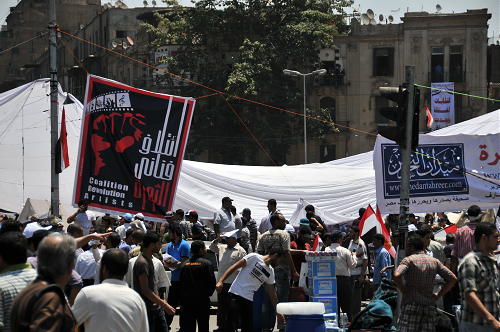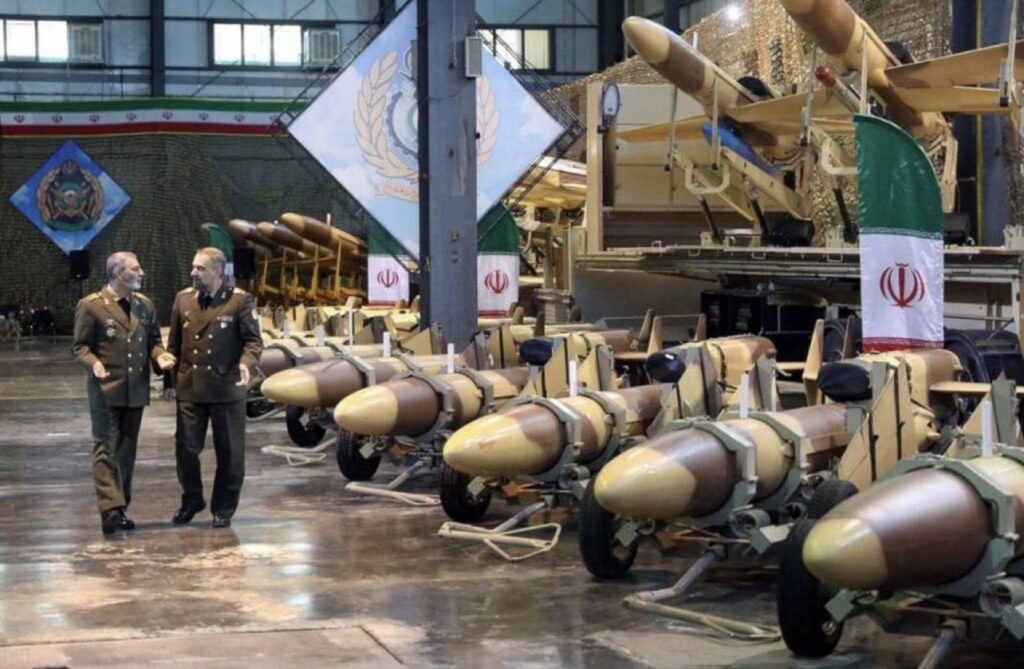UPDATES
Just What Exactly is Going On in Egypt?
Aug 5, 2011 | Daniel Meyerowitz-Katz

While most eyes have been directed at the public spectacle of the trial of former dictator Hosni Mubarak, a less visible but far more important trial has been facing Egypt as a whole. As Sharyn outlined on Wednesday, the increasing show of strength by Islamist forces in Egypt has dramatically altered the fabric of Egypt’s revolution.
The watershed moment came last Friday, when Islamist groups flooded Tahrir square – which had been occupied for months by liberal activists attempting to pressure the ruling Supreme Council of the Armed Forces (SCAF) – in order to reclaim the revolution from the “infidel liberals”. The square was promptly emptied by the armed forces, leaving the heart of Egypt’s revolution lying empty and posing numerous questions about the future.
The Brookings Institute’s Khaled Elgindy has written a detailed outline of the broad political landscape currently displayed in post-revolutionary Egypt. He observes that what began as a unified call for Mubarak’s fall has since descended into a fractured struggle between and within three broad factions.
One of the more striking features of the current transition is the extraordinary diversity and dynamism of Egypt’s burgeoning political landscape… Egypt has seen an explosion in civic and political activity across the country and in all areas of life… Competition, debate, and shifting alliances among the various youth, liberal, leftist, and Islamist forces unleashed by the revolution (including those who had opposed it) have brought Egypt’s once comatose political culture back to life – but not without a price.
The overriding impression one gets in Cairo today is of growing tension and polarization. The social and political unity that was so clearly on display this past winter has now vanished completely, as the various political forces that now occupy the country’s increasingly unruly political landscape jockey for power and influence… Broadly speaking, this is occurring at two levels simultaneously: the first is within the big tent of the opposition camp, mainly between Islamists and secularists but also among secularists themselves; and second between the mostly secular and liberal revolutionary forces and the country’s interim military rulers, the Supreme Council of the Armed Forces (SCAF). After months of simmering tensions, both of these exploded into full-blown confrontations in July.
Elgindy points to substantive and political differences creating the division between the secularists and the Islamists – particularly, allegations of Islamist collusion with SCAF and even the Mubarak regime as well as disagreement over the new constitution, which looks likely to give the Islamists a strong say. He then goes on to describe the deteriorating dynamic between the liberal protesters and SCAF, which has been increasingly resorting to Mubarak-era tactics in order to stave-off the impatient demonstrators.
Anyone visiting Tahrir today (or following it virtually through online social media) cannot but be struck by the intensity of the animosity directed at the SCAF and its leader, Field Marshall Hussein Tantawi, whom the Tahrir youth regard as a little more than an extension of the Mubarak regime. That sentiment is quite mutual. For its part, the SCAF sees the youth as a group of insolent and reckless kids with no understanding of politics. Despite affording them considerable latitude within the square, Egypt’s military rulers have launched an all-out assault on the youth movement and other pro-democracy forces, whom they view not only as a nuisance but also as threats to their interests.
… Stealing a page from the Mubarak playbook, the SCAF has resorted to innuendo-laden allegations against individuals and groups seen as threatening these interests… [These] efforts by the SCAF to delegitimize the Tahrir youth and discredit other civil society groups in Egypt, which can only be seen as an attempt to neutralize pro-democracy forces in the country, has the potential to derail the democratic transition altogether.

Journalist Michael Totten has been reporting on Tahrir Square from the ground, giving a fascinating insight into the true nature and motivations of the protestors there. His initial observations are a little disheartening – he observes that while the Mubarak regime lost its figurehead, it has not yet fallen. He also contrasts the Egyptian revolution with the 2005 “Cedar Revolution” in Lebanon, which was more female and more secular, but still failed to bring true democracy to what may be the most liberal of the Arab societies.
The Supreme Council of the Armed Forces, or SCAF, rules Egypt as a military junta, though you’d hardly know it as a casual visitor… It’s not even clear who the head of state even is, which is a highly unusual state of affairs for an Arab country.
… I can’t accurately count the number of people in crowds, but tens of thousands of people, and perhaps even more, filled that square. And I couldn’t help but compare Egypt’s revolutionaries with Lebanon’s. The massive demonstrations in Beirut in 2005 against Syria’s occupying military dictatorship looked and felt strikingly different. Far more women joined the Lebanon’s Cedar Revolution and fewer of them wore Islamic headscarves, partly because almost half of Beirut’s demonstrators were Christians, but also because Lebanon is a much more secular place.
Egypt’s revolution is significantly more masculine. And most of the women at the square wore the headscarf. My Egyptian colleague Yasmin dressed like a Western woman, and I saw other uncovered women there, too, but most dressed conservatively, even those affiliated with the liberal and socialist parties. One of the iconic images of Egypt’s revolution shows a victorious young woman wearing the hijab flashing the v-for-victory sign.
Don’t assume the headscarf means she’s with the Muslim Brotherhood or was demonstrating for an Islamic state. She probably isn’t and wasn’t. The headscarf is the standard dress code for women in Egypt regardless of politics.
What is striking about Totten’s various encounters is the rich diversity of views and ideas that he encounters. He describes meetings with organisations across the secular political spectrum – from socialists bragging about the worker’s strikes that brought Mubarak to his knees, to free-market libertarians giving their perspective on how to grow Egypt’s economy.

The diversity and the free exchange of ideas Totten describes is certainly encouraging. However, as he observes, it is only part of the picture.
Egypt’s liberals are out in large numbers, but they aren’t the strong horse. They’re third after the army and the Islamists. Events over the last week all but proved it.
Last Friday hundreds of thousands of activists from the Muslim Brotherhood and the even more radical totalitarian Salafist movement seized control of the square. They didn’t go down there just to yell at the army. They were there to intimidate liberals, and it worked. The Islamists “told their supporters to join in the demonstrations to fight against the liberal infidels,” a caller on the State TV show said. Thirty four different revolutionary groups-and that would be almost all of them-packed up and left for a while.
Then the army went in and cleared out those who remained. No one is at the square now. The soldiers tore down the tents and stepped aside as thugs from the Baltageya beat people up. Shop owners near the square cheered and applauded.
The unfortunate reality is that Tahrir square is not truly representative of Egyptian society. The protesters who have been occupying the square are mostly from Egypt’s young, well-educated, secular urban elite – albeit largely unemployed and impoverished. The Egypt that was not at Tahrir square is very different and, as explained by Foreign Policy‘s Marc Lynch, the liberals may have made a tactical blunder that has isolated them from the mainstream.
The decision to occupy Tahrir looks increasingly like a grievous strategic blunder. Their appeal to revolutionary legitimacy grows more threadbare by the day, absent direct engagement with the issues about which Egyptians really care. While they clearly felt that they had no other way to maintain pressure on the SCAF, the sit-in quickly alienated almost everybody. The violence led by hostile locals that greeted their march on the Ministry of Defense in Abassiya seemed to symbolize their loss of popular sympathy.
This perspective is illuminated when the actions of these liberals are contrasted with the Muslim Brotherhood’s. In an article in May’s New York Times Magazine, Robert Worth depicted the grassroots campaign that the Brotherhood has been conducting throughout Egypt in order to garner popular support.
“The truth is, there are no leaders in Kafr Shukr anymore,” [a chicken farmer from the village of Kafr Shukr] said in a loud, angry voice. “It’s only the Muslim Brotherhood that works here now.” Like others in the room, he seemed deeply anxious about the brotherhood’s rising influence. “They are in Kafr Shukr every day. They set up tents with bread, cooking oil, dried fish,” he said. “When they hear someone is sick, they bring medicines. They are at the level of the people. You say you have a popular committee, but I haven’t even heard of it. It is on Facebook, so what? Zakaria, if you want to do something here, you must be here every day like the brotherhood.”
As Egypt’s numerous Islamist forces show increasing influence, the threat of an Islamist revolution in Egypt along the lines of the Iranian revolution in 1979 is looking more and more real. Egypt’s liberal movements have a great deal of work to do if they are going to see what they started through to fruition. Right now, the odds are against them, and Western governments and NGOs who hope for democracy in the region should be thinking long and hard about what can be done to assist them to maximise their chances.
Daniel Meyerowitz-Katz
Photos by Michael Totten
Tags: Egypt











